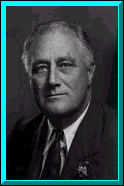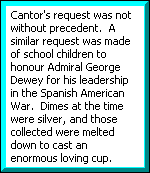









 
Photo courtesy of
the Roosevelt
Library Photo
Database

|
Page
1 | Page 2 | Page 3
In 1928, Alfred E. Smith, the Governor of New York, was running for
president. He nominated Roosevelt to take his place. Roosevelt walked to the
rostrum on the arm of his son, and made an impassioned nomination of Smith.1
Smith lost, but Roosevelt was elected Governor, and re-elected in 1930.
Roosevelt then began a campaign for the presidency. He was nominated
by the Democratic Party in 1932, and broke with tradition by flying to Chicago to accept
the nomination in person. Roosevelt was already deep into creating a conspiracy that
would conceal his pain and the extent of his paralysis.2
The ruse was effective, and Roosevelt was able to win the election on the promise to pull
the nation out of the depression.
Roosevelt had wanted to turn Warm Springs into a fashionable resort, but
it was slowly going broke. There were no endowments, and each summer's polio
epidemic added new survivors to the list of those who needed treatment. In 1933, the
fund-raising director, Keith Morgan, came up with the idea of promoting Warm Spring with a
series of charity balls held across the country. He named the local postmasters as
honorary chairmen of the committees that organized the dances. The dances were
scheduled to coincide with Roosevelt's birthday at the end of January. They were
called "Celebration Balls in Honor of the President's Birthday."
It was more successful than anyone thought possible. By 30 January
1934, six thousand "Birthday Balls" had been held across the nation. One
million dollars was netted to support the community at Warm Springs.
When November 1934 rolled around, the trustees of Warm Springs decided to
make the Birthday Ball an annual event. This looked like it was going to get
too big for them to manage, and they decided to establish an independent commission to
support research into the cause, treatment, and possible prevention of poliomyelitis.

The President's Birthday Ball Commission was poorly organized. Of
the eleven people who agreed to serve on the commission, only one had any experience in
medical research. Paul de Kruif had studied bacteriology at the University of
Michigan and worked in virology at the Rockefeller Institute before becoming a popular
science writer. He knew everyone in the field of microbiology, but he was not a
cautious man. He allowed the commission to fund intriguing but scientifically flawed
projects. One of them, the Brodie vaccine was ineffective and could cause severe
allergic reaction. It was released around the time as the Kolmer vaccine, which
actually caused polio and several deaths. Although the Kolmer vaccine was not funded
by the commission, both vaccines were connected with it in the public eye, and support for
the commission fell.
In 1937, Basil O'Connor urged Roosevelt to re-organize the commission to
distance himself from it. In September of that year, Roosevelt announced the
organization of the National Foundation for Infantile Paralysis. It was incorporated
in January 1938. The NFIP would continue to fund Warm Springs, but would also help
support polio victims around the nation and support research into the poliovirus, so that
the next vaccine would be safe and effective.
Almost immediately, the foundation got a new name. In a planning
meeting, comedian Eddie Cantor proposed using his radio show to solicit donations from
average Americans. A popular newsreel feature of the period was called "The
March of Time." Cantor called the fund-raising campaign "The March of
Dimes," and planned to ask each listener to send a dime to the White House to help
fight polio.
The first appeal for the "March of Dimes" was aired during the
last week of January 1938, to coincide with some Birthday Balls that were still being
held. Besides Eddie Cantor, the Lone Ranger also appealed to the nation's children
to contribute dimes to help fight the disease that had crippled and killed so many other
children.
Two days after the broadcast, the workings of the United States government
were brought to a screeching halt. The White House usually received 5,000 pieces of
mail a day, but on that day, 30,000 letters were received. The next day, 50,000
letters showed up. Then 150,000 letters arrived. The mail clerks couldn't find
the President's business letters. The White House chief of mail complained, "We
got fifty extra postal clerks, but we still couldn't find anything but scrawled and
finger-marked envelopes from every kid who could get his hands on a dime." When
all of the letters were opened, O'Connor discovered that his new foundation had raised
$1.8 million dollars, $268,000 of which had been mailed to the White House a dime at a
time.3
Page 1 | Page 2 | Page 3


Footnotes
1. Smith, Jane S. Patenting the Sun: Polio and the Salk
Vaccine. New York, New York: William Morrow and Company, Inc.
1990. p. 50.
2. Seavey, Nina Gilden, Jane S. Smith, & Paul
Wagner. A Paralyzing Fear: The Triumph over Polio in America. New York, New
York: TV Books. 1998. pp. 50.
3. Smith, Jane S. op. cit. pp. 65-75. |
